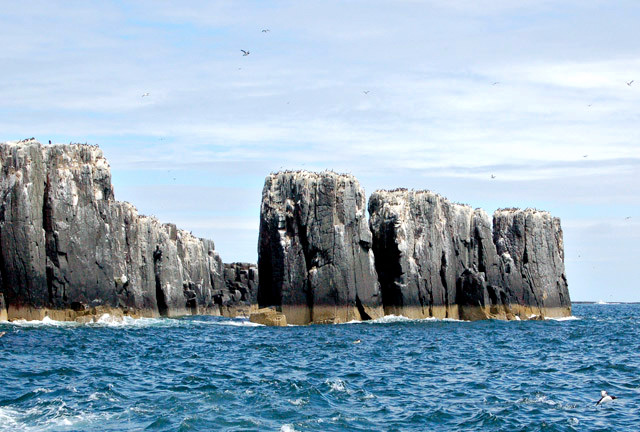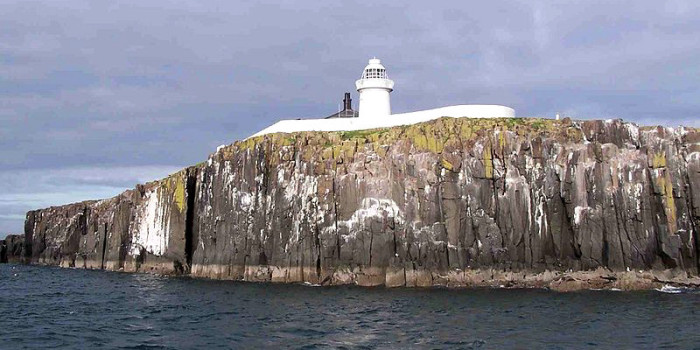Farne Islands
Farnes, Northumberland
|

Location Guide |
The Farnes are a group of islands of the
Northumberland coat, most get to them from Seahouses by boat. At the nearest
point they are around 2 miles off the coast. The largest islands are Staple and
Inner Farne, they are the breeding home to tens of thousands of seabirds,
including around 60,000 pairs of puffins, thousands of kittiwake, arctic tern,
eider duck, shags and guillemot, hundreds of razorbills. There are about 20
species here.

Staple Island Sea Stacks
 Andy
Andy

In the waters surrounding the Farnes are
around 6,000 Atlantic Grey Seals with their pups born every year during
September-November. Most of them take refuge on Brownsman Island which has not
public access, but boat trips on good seafaring days may give views from the
boat.
There are also a number of wrecks around the
Farnes popular with diving enthusiasts.
The Farnes consist of 15-28 islands,
including several which are only visible at low tide, they are constructed of
volcanic igneous rock on the eastern edge of a geological formation called
the Whin Sill. After the end of the Ice Age, you could have walked from
these islands across to the mainland, but rising sea levels cut them off,
making them a great place to enjoy wildlife.
Birds, what and where to see them
Around 20 different species, as many as
100,000 birds in total, make their home here during the breeding season
every year.
- Pufins. See them on Inner
Farne and Staple Island. Puffins are the most numerous breeding seabird on
the Farnes. They use sharp claws to dig burrows in the soil where they lay
their eggs.
- Arctic, Common and Sandwich
tern. Mostly found on Inner Farne. Each species has a
favourite bit of the island where it chooses to nest - the Arctic terns
prefer the grassy banks, paths and courtyard around St Cuthbert's Chapel
and the information centre.
- Razorbill and guillemot.
See them on Inner Farne and Staple Island. Like puffin, these are
members of the Auk family of seabirds. They nest in massive colonies on
the rocky cliff tops. Guillemots are the more slender of the two.
Razorbills are slightly smaller with a white-striped stocky bill.
- Shag. See them on
Inner Farne. Like guillemot and razorbill, shag nest on rocky cliff tops.
They forage for grasses, seaweed and anything else they can grab, to
construct large nests, which they guard noisily throughout the summer.
Often confused with cormorant, shag are smaller, with green-tinted
feathers and a tuft on their head in spring.
- Eider duck. See
them on Inner Farne. Britain's fastest flying duck and one that prefers
the coast.
- Kittiwake.
Nest on tiny ledges on cliff faces.
- Fulmar.
Nest on isolated cliff tops
- Greater and lesser black-backed gull
- Rock pipit.
Nest around the lighthouse on Inner Farne.
- Cormorant.
Nest on some of the smaller, rocky islands.
- Gannet.
Nest on Bass Rock off the Scottish coast but come south in search of food.
- Turnstone.
Nest hundreds of miles to the north but alongside
- Oystercatcher.
Oystercatcher and ringed plover are the only two wader birds who
breed on the islands. Unlike many of the seabirds, who migrate or live in
the North Sea after raising their chicks, they can be found here all year
round. Look out for the oystercatcher's bright orange eye, beak and legs
standing out from the seaweed on the rocky shoreline.
- Ringed plover.
Nest on the beach on Inner Farne.
- Passage birds in spring and autumn may
be seen for example Bluthroat (rare).
What else is there:-
- Range of butterflies and moths
- Porpoise and dolphins (occasionally)
- The islands' plant life includes
- scurvy grass to the scarce fiddleneck,
an invader from California, introduced by the lighthouse keepers many
years ago, and now growing wild. Flowering from May to August
- borage
- sea campion with its white flowers in
summer
- thrift flowering from April to August
- silverweed flowering from May to
September
- sorrel flowering from May to July
- Fourteen hundred years ago, St Cuthbert
came to live on the island for peace and solitude, and the small chapel
built in his memory can be visited.
- Peel tower a lookout and military
base from 1500, that was also its first lighthouse (fire on roof) now the
base of NT wardens
-
Inner Farne Lighthouse, Farne Islands, Northumberland


-
Longstone Lighthouse, Farne Islands,
Northumberland


-
Staple Island Lighthouse, Farne Islands, Northumberland



Inner Farne and
Lighthouse
 Mick Knapton
Mick Knapton

The boat trips
Several operators run trips, see under
access in the grid below, and there is a variety of choices
including:-
- Tours available of both Inner Farne and
Staple Island. The Inner Farne tour lasts approximately two and a
half hours including one hour spent on the island. The tour includes a
cruise around all the Farne Islands, viewing the sea birds on the cliff
faces, visiting the Grey Seal colonies and also follows the route Grace
Darling took her heroic rescue in 1838.
- During the breeding season (May 1- July
31) it is possible to make a morning landing on Staple Island and the
trips leave at 10am and 11am. This trip lasts approximately two and a half
hours including an hour on Staple Island itself. The trip also
includes sailing round all the other islands including Longstone and Inner
Farne and visiting the Grey Seal colonies at several vantage points with
full commentary en route.
- There is a also a whole day option
including visiting two islands.
Its worth comparing the offerings from
different operators to match your own interest.
Further information Grid
.
Planning Grid
|
Location: |
Farne Islands, Northumberland |
|
Grid Reference: |
NU 230370 |
|
Getting there: |
By road to Seahouses.
The nearest train service is Chathill, four
miles away (Sundays excluded). The closest bus service runs to Dunstanburgh
Castle and Seahouses. Arriva Northumbria 401, 501 Alnwick-Belford. |
|
Access: |
By Boat:-
There are boat trips every day from Seahouses
harbour, weather permitting. Organised trips are run by the RSPB in Summer.
There are no landings in rough weather.
Hanvey's Boat Trips, 29 King Street,
SEAHOUSES, Northumberland, NE68 7XW.
Telephone: SEAHOUSES (01665) 720388/720718
www.farneislands.co.uk/farne.html

Motor Vessel 'Glad Tidings' Billy Shiel M.B.E - Est. 1918
Seahouses - Northumberland.
Telephone: (01665) 720308
www.farne-islands.com

Golden Gate Farne Island boat trips (also
trip to and in Longstone lighthouse exclusive to this firm)
www.farneislandsboattrips.co.uk/
 (01665) 721210 (01665) 721210 |
|
Parking: |
At Seahouses, opposite the harbour (pay and
display) |
|
Facilities: |
WC on Inner Farne only |
|
Things To Do,
See and Photograph: |
Wide range of sea birds, puffins, maybe seals,
sea views, other opportunities depending on island visited, i.e.
lighthouse. |
|
What to take: |
Take a hat - watch out for the dive bombing
terns!
Snacks and drinks as the Farne Islands do not
have cafés.
Binoculars are a must for bird watchers.
Check the weather before planning a trip.
Take waterproofs and sensible footwear as the
weather can change quite quickly. |
|
Nature highlights: |
Breeding birds April - end July pos early
August. Grey Seal colony, sea birds and plant life |
|
Address: |
|
|
Postcode: |
NE68 7YT |
|
Telephone: |
01665 720651
01665 721099 (Infoline)
01665 720308 (William Shiel boat trips)
see others boat companies above under access |
|
Opening times: |
Different boat operators may operate different
schedules but an example is one that runs:-
During the Summer boat trips run daily to
Staple Island (morning) and Inner Farne (afternoon). Occasional boat trips
in the Autumn - phone for dates and times. In April, August and September
the tours of Inner Farne are available at 10am, 11am, 1pm and 2pm. Between
May 1st - July 31st it is possible to make a morning landing on Staple
Island with the trips leaving at 10am and 11am. An all day specialist tour
operates in the breeding season at 10am. Another operates a tour including a
lighthouse. The islands are only open when the boats run.
|
|
Charges: |
Boat trip (depending on trip) adults
£10-£25, Children £7-£15
Plus Farne's landing fee: National Trust, free
to NT members,
1st April to 30 April, and 1st August to 30
September, Adults £6.50, Children £3; Family £16.50 and 1st May- 31 July Adults £8,
Children £4, Family £20. |
|
Photo Restrictions: |
None |
|
Other Restrictions: |
Only Inner Farne and Staple Islands can be
visited. Visitors to Inner Farne in June should wear hats |
|
Special Needs Access: |
Inner Farne - there is a walkway round the
island suitable for disabled visitors.
Staple Island is a rocky island and is not
recommended for disabled visitors. |
|
Special Needs Facilities: |
None |
|
Children Facilities: |
Don't take young children to Inner Farne in
June. |
|
Dogs Allowed: |
NO |
|

|
Please let us know any other information that we
can add to the Grid(s) or page and any errors that you discover. Before making a long trip to any location it is always
wise to double check the current information, websites like magazines may be
correct at the time the information is written, but things change and it is of
course impossible to double check all entries on a regular basis. If you have
any good photographs that you feel would improve the illustration of this page
then please let us have copies. In referring to this page it is helpful if you
quote both the Page Ref and Topic or Section references from the Grid below. To print the
planning grid select it then right click and print the selected area.
Please submit information on locations you discover so
that this system continues to grow.
|